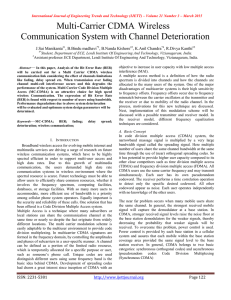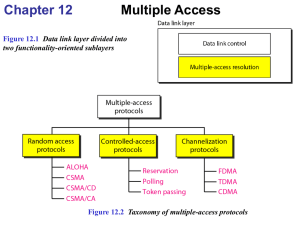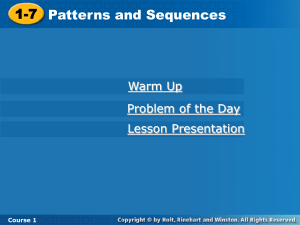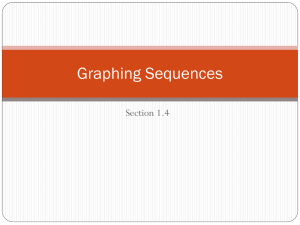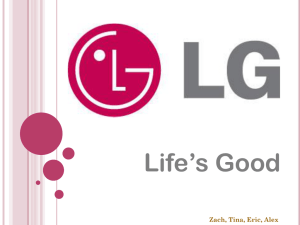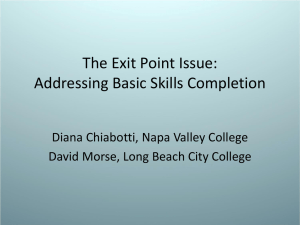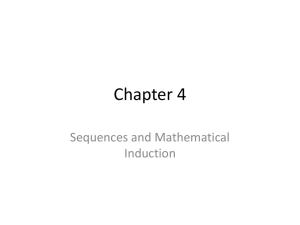MC-CDMA systems
advertisement
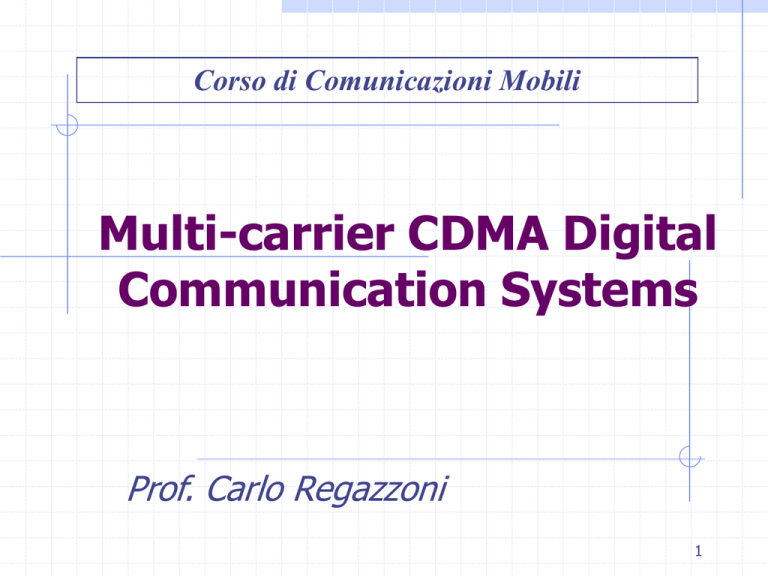
Corso di Comunicazioni Mobili Multi-carrier CDMA Digital Communication Systems Prof. Carlo Regazzoni 1 References [1] N. Yee, J.P. Linnartz, “Multi-Carrier Wireless Radio Channel”, Tech. Rep. Of at Berkeley, 1994. [2] S. Hara, R. Prasad: “Overview of MC-CDMA”, Communications Magazine, Dicembre 1997, pp. 126-133. [3] Z. Wang, G.B. Giannakis, “Wireless Multicarrier Communications – Where Fourier Meets Shannon”, IEEE Signal Processing Magazine, Maggio 2000, pp. 29-48. [4] H. Liu, “Signal Processing Applications Communications”, Artech House: Boston 2000. [5] B. M. Popovic, “Spreading Sequences for Multicarrier CDMA Systems”, IEEE Trans on Comm, Vol.47, No.6, Giugno 1999, pp. CDMA in an Indoor University of California in IEEE CDMA 918-926. [6] Edizione speciale della rivista EUROPEAN TRANSACTIONS ON TELECOMMUNICATIONS (ETT) su Multi- Carrier Spread Spectrum, Vol. 10, 2 No. 4, Luglio-Agosto 1999. Introduction The Multi-carrier CDMA techniques (MC-CDMA) were born from a fusion of the OFDM technology and the CDMA techniques. The idea of combining together the OFDM two technologies is very recent. MC-CDMA The first publication which presented CDMA the basic idea of the MC-CDMA was in 1994 by Yee e Linnartz [1]. Hence it’s a technique still in experimental phase. But the results of the experimentations pointed out its robustness, so much to propose the MC-CDMA as a valid alternative to the DS-CDMA in case of transmissions in environments where the propagation drifts due to the channel are very hard and where there are many transmitting users. The basic idea of the MC-CDMA techniques consists in overlapping a certain number of transmitting users on the same set of sub-channels orthogonally spaced in frequency. Each user is distinguished by a different PN code, called signature code. 3 General Overview: MC-CDMA Transmitter Orthogonal multiplexing in the frequency domain of the same bit on more carriers. fl fc lF T l 0 .. N 1 Where: F is the index of spacing of the carriers (for F = 1 carriers are spaced like in a normal OFDM) T s m (i ) is the symbol time i-th chip of the PN sequence associated to the m-th user The signal transmitted by the m-th user is the following: u m ( t ) Re D m ( n ) P ( t nT ) N l 1 s m ( l 1) e j 2f l t Where P(t) is the rectangular pulse with unitary energy. nT t ( n 1)T 4 General Overview: MC-CDMA Signal Spectrum F=1 ………… f f1 f2 f3 fN BT F=2 … … … … … … … ... f1 f2 f3 fN f 2BT It can be verified that the bandwidth required for an MC-CDMA transmission is: BT F N 1 T Increasing F, the required bandwidth grows, but also the diversity of the transmitted signal and then its robustness against noise and multipath fading. 5 General Overview: MC-CDMA Demodulator Under the hypothesis of synchronous transmission on an AWGN channel and coherent demodulation, the following expression for the decision variable, sampled each t = T, can be obtained: Y m ( 0 ) Re N l 1 Ym(n) * s m ( l 1) y l ( 0 ) M yl (0) where ( D ( 0 ) s ( l 1) n ) i i l i 1 M = number of active users Di (0) nl symbol transmitted by the i-th user in t = 0 addictive Gaussian noise 6 General Overview: Comparison With OFDM The OFDM technique is used to increase the duration of the modulated symbol, so as to reduce the effects, in terms of inter-symbolic interference (ISI), caused by multipath channels characterized by a huge delay spread. Multi-user transmission is possible only by assigning to each user a different set of sub-carriers (multi-carrier FDMA or MC-FDMA) or by sharing the same set of sub-carriers on some temporal slots (MC-TDMA). The MC-CDMA technique performs a spreading of the signal in the frequency domain, by transmitting every bit (or symbol) in parallel on N different orthogonal sub-carriers. Every sub-carrier is characterized by its own phase offset imposed by the PN sequence. Multiple access in CDMA modality means that different users may use the same set of sub-carriers. If the PN codes are orthogonal (Hadamard-Walsh sequences) and the users transmit in a synchronous way on an AWGN channel there is no MUI. 7 General Overview: Comparison With DS-CDMA The DS/CDMA techniques perform the signal spreading in the time domain; multiple access is implemented by using the same bandwidth for more than one asynchronous user. But the MUI increases and becomes troublesome if the number of users is huge. If multipath fading is present, it’s possible to use DS/CDMA Rake receivers to take advantage of the diversity to reduce strongly the effects of the attenuations of the signal. But the performances of this kind of receivers are heavily limited by the presence of the MUI, especially if the equalization is not ideal. Then very complex algorithms to cancel the MUI to optimize the performances (the complexity of the receiver increases). The MC-CDMA systems allow to manage in an efficient way the simultaneous transmission of a good number of users on a multipath fading channel; the receiver uses low-complexity techniques, based on the definition of the gains as a function of the characteristics of the channel, without the necessity of using RAKE schemes. 8 Implementation: FFT and spreading orthogonality The MC-CDMA schematic can be implemented like a DS/CDMA transmitter, where the signal which has to be transmitted is multiplied by the inverse Fourier transform of an Hadamard-Walsh sequence (or of another orthogonal code), as show in the figure The major robustness of the MC-CDMA techniques respect to the DS/CDMA techniques is evident: they own a natural orthogonality of the frequency spreading, which is not completely destroyed by the drifts of the synchronism due to transmission delays or multipath propagation. To recover orthogonality in case of DS/CDMA, very complex equalization and multi-user detection algorithms are needed. It’s simpler in case of MCCDMA transmission. 9 Choice of the PN Sequences in a MC-CDMA System The MC-CDMA multi-user transmission cannot be always synchronous. Synchronization drifts can be caused by transmission delays of a user respect to another one (as it usually happens in the upstream transmission) or by propagation drifts of the channel (multipath fading) which render amplitude and phase distortions of the transmitted signal. Selection criteria of the PN signatures in an asynchronous MC-CDMA system are conditioned by the values of the following parameters 1. Peak to Average Power Ratio (PAPR) 2. Dynamic of variation of the envelope of the complex transmitted signal 3. Multiple Users Interference (MUI) An optimal choice of the codes which minimize the values of the three previous parameters is needed. The previous criteria are valid under the hypothesis of fixed bit-rate transmission. In case of variable bit-rate the codes have to be with different length. 10 Choice of the PN Sequences in a MC-CDMA System The PAPR parameter of the MC-CDMA signal transmitted by the m-th user is 2 defined in the following way: PAPR ( u m ) max u m ( t ) 0 t T T 1 T 2 u m ( t ) dt 0 Sometimes the square root of the PAPR is used. In this case it is called crest factor and it’s a parameter which measure the compactness of the envelope of a signal. One of the main disadvantage of the OFDM systems (inherited by the MCCDMA systems) is represented by the high value of the PAPR parameter (and then of the crest factor). This disadvantage reveal itself when the transmitted signal is amplified by devices characterized by an high input back-off. It is due to the general behavior of the amplifier which cuts the amplitude peaks which overcome in modulus the value of the voltage supply (generally 12 V). This fact causes heavy distortions of the received signal which can be prevented only by compressing at most the envelope of the transmitted 11 signal, i.e. reducing the crest factor Choice of the PN Sequences in a MC-CDMA System It can be proved that in a MC-CDMA system the crest factor satisfies the following inequality: max S ( f ) CF ( u m ) E 2 Where S(f) is the Fourier spectrum of the PN sequence s m (i ) (periodical signal), while E is the energy of the sequence. If PN sequences, whose spectrum has an envelope sufficiently compressed, are chosen, it’s possible to reduce the crest factor. From this point of view the poly-phase sequences seem advantaged respect to the binary ones. The following figure shows how the crest factor vary changing the PN sequence 12 Choice of the PN Sequences in a MC-CDMA System The dynamic range of the complex signal is strictly bounded to the crest factor and it is defined as: max S ( f ) DR ( u m ) 20 log 10 min S ( f ) If the signature sequence has an envelope which is as much as possible constant, the minimization of the crest factor is reduced to the problem of finding an initial phase for the orthogonal sub-carriers which minimize the absolute maximum of the transmitted signal. The figure shows the comparison between the dynamic range in case of binary sequences (Gold) and in case of four-phases sequences (Zadoff-Chu), which grants a minor dynamic range of the system. 13 MUI: General Considerations As formerly seen, the MUI due to perfectly synchronized users in a MC-CDMA system depends only on the scalar product between non-shifted PN sequences, i.e. on the cross-correlation between the two sequences, computed under the hypothesis of null delay. In this case, under the hypothesis of non-distortive channel (AWGN), MUI is absent if mutually orthogonal sequences, like Hadamard-Walsh ones, are used. The perfect synchronization can happen only in the downlink channel. In the uplink channel the users are not mutually synchronized and then rise up the MUI, even if the channel is ideal. 14 MUI: Mathematical Model Supposing that the interfering signal x from one user is received and despreaded by the receiver of the user y together with the desired signal uy(t). The receiver is a MC-CDMA matched filter based receiver and the employed modulation is the BPSK. Assuming that the signal from the user x is delayed respect to the temporization of the receiver of the user y by a time τ, i.e. uy(t+ τ). The interference, applied by the user x on the user y, can be represented in the following way: T T * * * * I xy ( ) Re D x ( n ) w x t w y t P ( t ) P ( t ) dt Re D x ( n 1) w x t T w y t P ( t T ) P (t ) dt 0 T N where w m ( t ) ˆ s m l 1 e j 2f l t 0 T l 1 D x (n ) is the bit transmitted by the interfering user in 0 t T D x ( n 1) is the bit transmitted by the interfering user in T t T 15 MUI: Mathematical Model Supposing that: D x ( n ) D n 1 The interference is reduced to: Where: I xy ( ) Re xy N xy ( ) s x ( l 1) s y ( l 1) e * j 2 f l l 1 is called odd spectral correlation function between the PN sequences of the user x and of the user y. Supposing that: D x ( n ) D n 1 The interference can be approximated in the following way: Where: ˆ xy ( ) ˆ 1 I xy ( ) Re ˆ xy 2 xy ( ) T Is called even spectral correlation function between the PN sequences of the user x and of the user y. 16 MUI: Mathematical Model In the case of perfectly synchronized users, the spectral correlation function is reduced to the cross correlation function between the PN sequences of the user x and of the user y, computed in τ = 0. It’s now possible to express the MUI as a summation of all the possible interference among the couples made of the reference user and the other M 1 interfering users: I I i ,m i i 1 i m Likewise for the asynchronous DS/CDMA, the computation of the pdf of the MUI in a MC-CDMA system is very complicated from the numerical point of view. In fact (M-1) convolutions of the following type are required (supposing that #1 is the reference user): f ( z ) f ( z ) * f ( z ) * ....... * f (z) I I 2 ,1 I 3 ,1 I M 1 , 1 Certainly for a huge number of users (common situation in MC-CDMA applications), a Gaussian approximation can be considered. Anyway simulative evaluations of the performances of the MC-CMDA systems are privileged. 17 MUI: Influence on MC-CDMA Asynchronous System The following figure shows some experimental curves which point out the trend of the BER in a MCCDMA system with four asynchronous users, as a function of the signal-tonoise ratio for a fixed process gain equal to 32 (Hadamard-Walsh or orthogonal Gold sequences) or 31 (normal Gold sequences or fourphase Zadoff-Chu sequences). The system is tested on an AWGN channel 18 Comparison with DS/CDMA It’s now possible to make a comparison between the previous figure and a figure which shows the trend of the BER for a DS/CDMA system which operates on an AWGN channel, based on very narrow upper and lower bounding curves (Gold and Hadamard sequences): 19 Comparison with DS/CDMA By using Gold sequences in the DS/CDMA system provides sharply worse results than in the MC-CDMA system. The curve relative to the use of Hadamard-Walsh sequences provides in the DS/CDMA system results not much worse than in the MC-CDMA system. On an AWGN channel the grater orthogonality, offered by the MC-CDMA techniques respect to the DS/CMDA ones, shows up particularly when signature sequences, characterized by good correlation properties, are used. 20 Variable Bit-Rate Transmission The MC-CDMA techniques can also be used for the management of transmissions with variable bit rate (VBR) simply by allocating each class of users on sets of sub-carriers with different cardinality. Supposing that, how usually it happens in digital VBR transmissions, C classes of users with different bit-rate are formalized in the following way: rbi 2 ( i 1 ) rb 1 i C The orthogonality between the sets with different cardinality of orthogonal subcarriers is granted by allocating the user of the i-th class on the set of subcarriers with cardinality Ni, defined in the following way: F i 1 N f li f c ( 2 1) rb l i Fr bi 1 i C 0 l i i 1 1 2 2 If F is odd, all the signals, transmitted by all the classes of users, occupy the same bandwidth. If F is even, the required bandwidth is different for each class and, generally is imposed by the user with higher bit-rate. 21 Variable Bit-Rate Transmission f11 f21 f12 f31 f13 f22 BT f41 f CASO F=2: utenti a 1, 2 e 4 portanti 4 rb 2 rb f f 11 f 21 f 31 f 12 f 41 f 22 BT CASO F=1: utenti a 2 e 4 portanti 22 Choice of PN Codes for VBR Transmissions To transmit VBR in MC-CDMA modality, an accurate choice of mutually orthogonal PN codes with variable length is required; the codes are generated the following tree-like structure similar to the pseudo-Hadamard one formerly seen. This kind of codes have not very good correlation properties when they are used in asynchronous systems. However it’s better to use these codes instead of Gold codes with different length, because the correlation properties are valid only for family of codes with the same length. 23 MC-CDMA Receivers: General Overview MC-CDMA techniques are suitable for transmission on multipath channels; in fact it’s possible to take advantage of the natural diversity provided by these techniques and it’s possible to recover the orthogonality of the signal by lowcomplexity reception algorithms. If the signal is distorted by a multipath channel selective in frequency, the decision variable (in case of synchronous transmission) has the following expression: N ~ * ~ Y m ( 0 ) Re s m ( l 1) y l ( 0 ) l 1 M where ~ yl (0) (z il D i ( 0 ) s i ( l 1) n l ) i 1 z il il e j il il Distortion coefficient (complex and time-variant) relative to the l-th carrier of the i-th user Attenuation, Rayleigh distributed il Phase delay, uniformly distribute between 0 and 2π 24 MC-CDMA Receivers: General Overview The previous equations point out that on a multipath channel, even in case of synchronous transmission, some MUI is generated. Furthermore the signal is received distorted by the multipath channel. A MC-CDMA receiver to use on a multipath channel can be schematized in the following way: It’s equal to the one seen for the AWGN channel but the reception coefficients d ml l 1,..., N can be expressed as: d ml ml s m l 1 * where the term μml is a complex coefficient, properly chosen to equalize the distortions introduced by the channel. 25 Receivers: Orthogonal Restoring Combining (ORC) It’s the algorithm with the lowest complexity. It’s supposed to have, before the decision block, an equalization block which allows to estimate in a sufficiently accurate way the coefficients of distortion of the channel: ˆ Equalizzatore y(t) il e j il MC-CDMA Under this hypothesis, the coefficients of distortion can be expressed as follows: s i l 1 e * d il ˆ il j ˆil 1 l N 1 i M 26 Receivers: Orthogonal Restoring Combining (ORC) This method requires an efficient equalization algorithm for MC-CDMA systems (OPEN PROBLEM). The blind methods are computationally heavy and generally inefficient. The adaptive methods which use training sequences are more efficient, but they introduce redundancy in the transmitted message. Moreover, the most attenuated sub-carriers have to be multiplied by high gains to compensate the attenuation. But the noise too is amplified as much as the signal. This over-amplification of the noise can seriously compromise the performances of the method in terms of BER rise. 27 Receivers: Equal Gain Combining (EGC) The Equal Gain Combining (EGC) is the reception algorithm which doesn’t operate any kind of equalization, i.e.: d il s i l 1 * Experimental tests pointed out that, in some cases, EGC algorithm allows better performances than the ORC method, especially when few transmitting users are present. It happens because the effects of the over-amplification of the noise, in correspondence of the most attenuated sub-channels, and the imperfections of the equalization process hardly compromise the efficiency of the ORC. 28 Receivers: Maximum Rate Combining (MRC) The Maximum Rate Combining (MRC) method is a variant of the Orthogonal Restoring. The reception coefficient can be expressed in the following way: d il s l 1 ˆ il e * i j ˆil s i ( l 1) zˆ il * * The least attenuated components of the received signal have an high probability to be the least noisy too. The MRC criteria gives them a major weight in the decision process. The MRC algorithm minimize the BER in the single-user case, but its efficiency quickly decrease, increasing the number of users. 29 Receivers: Controlled Equalization (CE) To overcome the disadvantages of the over-amplification of the noise, controlled equalization methods were introduced. The simplest of these methods uses, as decision variable, the summation of the equalized base-band components, whose amplitude is major than a fixed threshold: j ˆ * s i l 1 e il d il U ˆ il ˆ il U(x) is the unitary step function, while γ is the threshold. The components, whose estimated amplitude is under the threshold, are practically removed from the decision process ( d = 0 ). It can be proved that, for a given signal-to-noise ratio, it’s possible to extract a value of the threshold which minimize the BER. Other equalization methods proposed in literature perform a mediate equalization, i.e. from the different coefficients dil obtained the average value is computed to have an uniform equalization of all the components of the received signal and the over-amplification is avoided. 30 Receivers: Mean Square Error Combining (MMSEC) The MMSEC receiver is based on a minimum square error estimation criteria, i.e. it requires to find a matrix of coefficients dil : ˆ D m ( 0 ) Re N l 1 M ~ d il y l ( 0 ) ~ yl (0) (z il D i ( 0 ) s i ( l 1) n l ) i 1 which minimize the mean square error between the estimated symbol and the symbol which was really transmitted. The following matrix of coefficients is obtained: s i l 1 zˆ il * d il M * zˆ il 2 N0 1 i M 1 l N For small values of zˆ il the reception gain becomes small to avoid an excessive amplification of the noise. zˆ il For high values of the reception gain becomes proportional to the 2 inverse of the estimated envelope factor, i.e. to recover the zˆ il 31 orthogonality Receivers: Numerical Results The receiver which provides the best performances is the MMSEC. Its performances are next to the theoretical lower bound even with a huge number of users. The ORC receiver has not very interesting performances. The EGC and the MRC receivers seem to perform better with few users, at least in this specific case of study. The MRC receiver provides the worst performances when the number of users becomes huge. 32 Comparison with DS-CDMA The case of transmission with variable bit-rate on a low-orbit satellite channel is considered. T otal N u m ber of u sers 64 carriers u sers 32 carriers u sers 16 carriers u sers 2 3 4 5 1 1 1 2 0 1 2 2 1 1 1 1 Classes of users Number of subcarrier 64 32 16 Bit-rate 512 Kb/s 1 Mb/s 2 Mb/s Block length 14 bit 28 bit 56 bit # of data bits for block 9 23 51 Number of required bits for the training sequences DS-CDMA with RAKE receiver and ideal equalization (dashed line). MC-CDMA with mediated equalization (continuous line) Hadamard-Walsh sequences with variable length are used 33 Multi-carrier Spread Spectrum MC-SS The Multi-carrier Spread Spectrum (MC-SS) is a multi-carrier modulation technique which consists on assigning to each user the same signature code, but a different frequency offset for a correct distinction of the users. The MC-SS techniques are intrinsically more robust against the effects of the MUI, respect to MC-CDMA techniques. By using opportune signature codes it’s possible to obtain better results, in terms of BER, respect to the MC-CDMA systems. A larger bandwidth is required for this kind of transmission. 34 Multi-tone CDMA (MT-CDMA) The Multi-tone CDMA is a multi-carrier modulation technique which consist on a transmission, for each user, of a DS-SS signal on N orthogonal carriers. Practically is a mixture of DS-CDMA and MC-CDMA techniques, as shown in the following figures: MT-CDMA transmitter MT-CDMA receiver This kind of schematic allows, under the condition of equal length of the spreading codes, to manage a major number of simultaneous users respect to a DS-CDMA schematic because the orthogonality of the various users is improved. But no substantial increase of the capacity of the system, respect to the MC-CDMA systems, is observed, because inter-carrier interference heavily 35 conditions the performances of the system.

